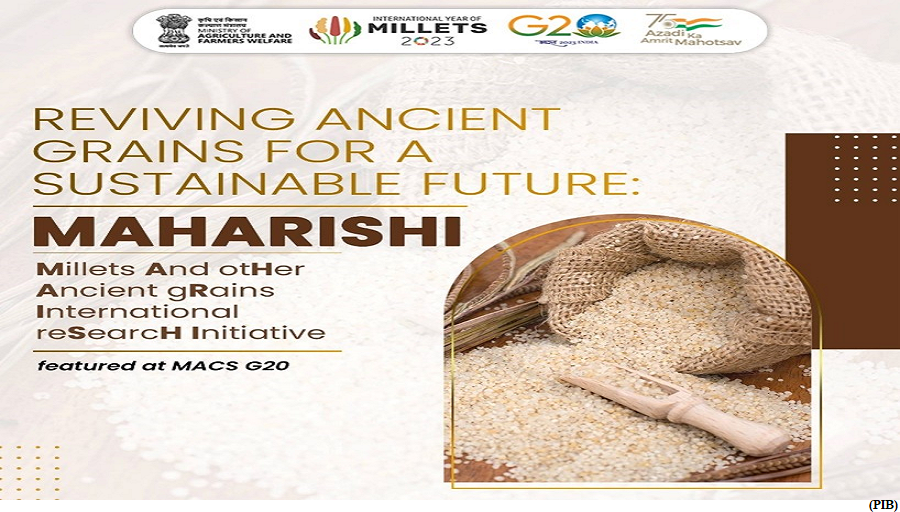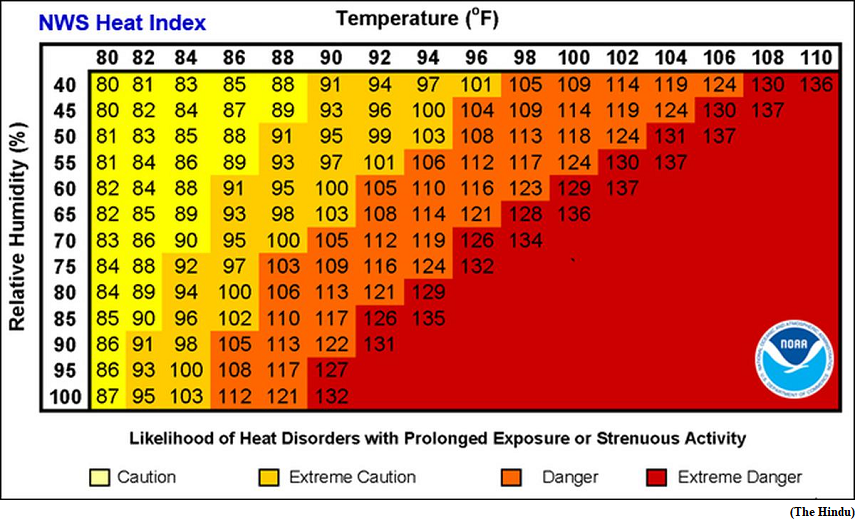MAHARISHI Initiative (GS Paper 3, Economy)

Context:
- During the 100th G20 meeting under India's presidency, the meeting of agricultural chief scientists (MACS), reached the unanimous decision to launch an initiative named MAHARISHI.
- This stands for ‘Millets And Other Ancient Grains International Research Initiative’.
Aim:
- This initiative is aimed to bolster research and awareness concerning agro-biodiversity, food security, and nutrition, aligning with the International Year of Millets 2023 (IYoM 2023) programme initiated by the United Nations General Assembly (UNGA).
- MAHARISHI is a Sanskrit acronym for an initiative proposed by India towards advancing research in the field of millets and other ancient grains.
Details:
- The initiative's secretariat is based at the Indian Institute of Millets Research (IIMR) in Hyderabad, with crucial technical support from the International Crops Research Institute for the Semi-Arid Tropics (ICRISAT), One CGIAR Centres, and other international organisations.
- This was decided in April during the 12th MACS meeting. The theme of the meeting was ‘Sustainable Agriculture and Food Systems for Healthy People and Planet’.
What is the purpose of the initiative?
- India's MAHARISHI Initiative was conceived to address the challenges of dispersed efforts in research across various grains. It aims to focus on millets and other underutilised grains.
Its goals include:
- Enhance food security and nutrition: MAHARISHI aims to facilitate research collaboration on climate-resilient and nutritious grains, including millets and other ancient grains. This effort complements the ongoing International Year of Millets 2023 programme.
- Strengthen agricultural resilience: Through approaches like climate-resilient agriculture and "One Health", the initiative aims to build resilience in agriculture systems which can contribute to sustainable food production.
- Digital transformation: It promotes digitalisation in agriculture, embracing technology to modernise and transform agricultural practices.
- Public-private partnerships: MAHARISHI fosters collaboration between public and private organisations to advance research on these grains, identifying research gaps and needs.
The Chinese roadblock:
- Although the MAHARISHI acronym was included in the outcome document released after the G20 Meeting of Agricultural Chief Scientists (MACS) in April, China raised objections to using a Sanskrit acronym in international documents.
- China did not object to the proposal itself, instead, it highlighted a broader linguistic and cultural challenge.
- As a result of this objection, the acronym MAHARISHI was omitted from the chair's summary released after the G20 Agriculture Ministers' meeting in June. It remains to be seen whether it will return to the joint declaration.
- China had also previously raised objections to using the Sanskrit phrase "Vasudhaiva Kutumbakam" in G20 ministerial outcome documents, a Sanskrit is "not recognised as an official language by the UN."
Collaboration and knowledge sharing:
- The MAHARISHI initiative also seeks collaboration with various organisations and institutions to disseminate research findings and identify gaps and needs.
- A web platform is also in the works to facilitate communication and information sharing among researchers in an open and accessible manner.
- Additionally, India has proposed knowledge transfer activities on millets, including capacity-building initiatives and international research workshops and conferences, to encourage researchers to work on these grains.
Way Forward:
- India's MAHARISHI Initiative is a significant step toward addressing global food security, nutrition, and sustainable agriculture challenges.
Impact of RBI’s lending guidelines
(GS Paper 3, Economy)
Why in news?
- Recently, the Reserve Bank of India (RBI) issued guidelines enabling a borrower to transition from a floating interest rate-based loan to one with a fixed interest rate.
- The endeavour was to address borrowers’ grievances pertaining to the elongation of loan tenure and/or an increase in the EMI amount in the event of an increase in the benchmark interest rate.
- A lack of proper communication along with the absence of consent formed part of the concerns. The provisions would be extended to existing as well as new loans by the end of the current calendar year.

What exactly has the RBI instructed?
- It has given borrowers the option to switch over to a fixed (interest) rate mechanism for their loans from floating rates. This would be based on a board-approved policy drafted by the lending entity. The policy must also specify the number of times such a switch would be allowed during the tenure.
- The lender must also transparently communicate to the borrower all relevant charges alongside service charges or administrative costs associated with the transition.
- The borrower would now also have the option to choose between enhancement of the EMI or elongation of the tenure or a combination of both. S/he might also opt to prepay the loan, either in part or full, at any point during the tenure. This would, however, still invite foreclosure charges or pre-payment penalty.
- RBI has sought that lending entities provide borrowers, through appropriate channels, a statement at the end of each quarter enumerating the principal and interest recovered till date, EMI amount, number of EMIs left and annualised rate of interest/ Annual Percentage Rate (APR) — for the entire tenure of the loan. RBI has asked for the statement to be “simple and easily understood by the borrower”.
- The instructions would apply to all equated instalment-based loans of different periodicities albeit with certain changes based on the nature of the loan.
What is the difference between a fixed and floating interest rate?
- Fixed interest rates are those that do not change during the tenure of the loan. On the other hand, floating interest rates are subject to market dynamics and the base rate, therefore, the risk differentiation.
- The floating interest rates are generally lower than fixed interest rates. For example, if the floating interest rate for home loans is 10.5%, the fixed interest rate would be 12%.
- Lenders argue that even if the floating interest rate were to rise by up to 2.5 percentage points, the borrower would be able to save more money when it is below the fixed rate. It has been widely argued that their preference for the floating rate-based regime is to better adjust their positions as per the evolving market dynamics.
- The advantages are transmitted onto the borrower’s savings pool, but the opposite also holds true in a rising benchmark rate regime. The floating interest rate loans do not draw any prepayment penalty unlike fixed rate loans.
- However, the fixed rate-based regime endows a borrower with greater certainty and security. This also helps in better planning and structuring of individual budgets. Thus, prospective borrowers should note broader evolving economic dynamics and accordingly decide the tenure they seek.
What is RBI’s stance on assessing repayment capacity?
- RBI stated in the circular that lending entities are required to consider the repayment capacity of the prospective borrower. This is to allow borrowers adequate (or optimum) headroom/margin for elongation of tenure and/or increase in EMI.
- About parameters for assessment, the banks would have to consider the payment capacity of the borrower and how longpayment capacity would last (the age factor).
What is heat index and why is it important to measure?
(GS Paper 3, Environment)
Why in news?
- Earlier in August, Iran recorded a scorching heat index of 70 degrees Celsius (°C) in the coastal part of the country, a metric at which survival of life is unfathomable, if not impossible.
- In July, U.S.-based weather observer Colin McCarthy reported that the Persian Gulf Airport recorded a heat index of 66.7 °C.

What is heat index?
- Heat index, also known as apparent temperature, is a measure of how the temperature feels to humans.
- Relative humidity is an important factor that determines heat index, along with air temperature.
How is the heat index calculated?
- A complex formula to calculate heat index was published by Dr. Robert Steadman, a professor in the textiles and clothing department of Colorado State University, in 1979.
- His study considers a “typical adult human of either sex, with a height of 1.7 metres and a weight of 67 kg.”
- Dew point, which is the temperature at which gas is transformed into a liquid state, is an important factor in the calculation of heat index. In terms of atmospheric moisture, it’s the temperature at which air cannot hold any more water vapour, and droplets of water begin to form.
- He used 14 °C as the dew point in his calculations. Some countries have developed their own corresponding indices to measure heat index instead of using the one developed by Dr. Steadman.
Is it important to measure the heat index?
- Hot air can hold more moisture than cold air. Therefore, when temperature rises, the air’s capacity to hold moisture also increases, thus affecting the apparent temperature or heat index.
- Humidity is typically higher during heat waves, which is why the heat index at the time is usually higher than just the temperature because humid air can feel hotter to humans.
How does high humidity impact the human body?
- High humidity can lead to heat stress, meaning the body is unable to get rid of excess heat. Humans usually maintain a core temperature in the range of 36.1 to 37.2 °C.
- When the body is unable to get rid of excess heat, the heart rate increases due to a rise in core temperature, leading to heat-related exhaustion and rashes, among other symptoms. It can also be fatal if not addressed promptly.
- At high temperatures, the human body can lose excess heat through perspiration and cool itself. But when humidity is high as well, it is difficult to sweat and then for that sweat to evaporate because the air around is already saturated with moisture. This makes it difficult for the body to lose heat.
- On the other hand, if the humidity is low, evaporation of sweat is easier, thus making the apparent temperature feel close to the actual air temperature.
- This is why a measure of heat index is more useful than just the temperature to gauge the impact of heat on humans.
What measures can we take to adapt?
- A heat index value of 67°C or above can be extremely dangerous for people and animals who have direct and prolonged exposure.
- There is need to prepare and adapt to such extreme conditions by investing in early warning, making changes to work timings, and finding sustainable cooling solutions.




